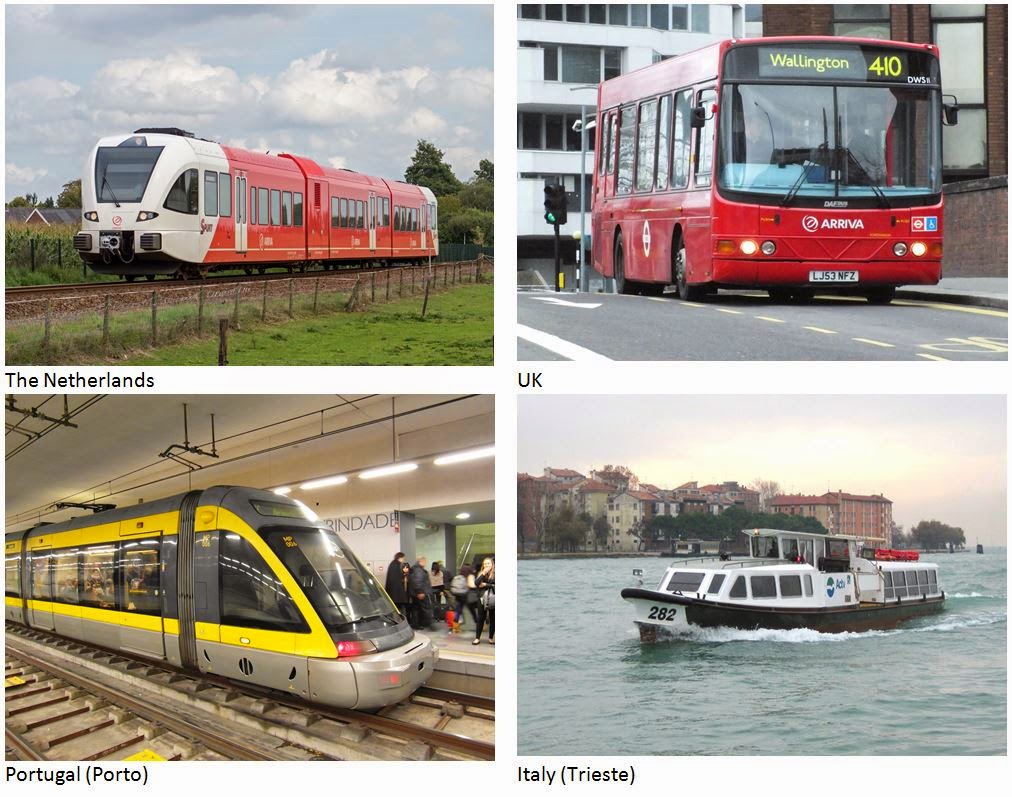Other key figures - back to Homepage
Great-Britain – Train/bus/light rail/waterbus operator – 14 countries
Subsidiary of DBAG
– 55,000 people – 2.2 billion journeys
Since 1997, Arriva
is the name of a public transport company established in 1938. In 2010,
the company became a subsidiary Deutsche Bahn for the outside operations
and is headquartered in Sunderland (UK). Arriva is one of the largest providers of passenger
transport in Europe, employing more than 55,000 people and delivering more than
2.2 billion passenger journeys across 14 European countries each year. The
company operates a wide range of services including local buses, inter-urban
commuter coaches, local, regional and national train services, trams and light
rail, waterbuses, demand response, non-emergency patient transport and airport
related transport services:
Rail services
Arriva European rail network spans the UK, the Czech
Republic, Denmark, the Netherlands, Poland, Portugal and Sweden. The UK is the
largest rail market of Arriva, where it operate six different train services,
from the CrossCountry route spanning the length of England and Scotland to
London Overground Rail Operations. The UK passenger rail market is at a mature
stage of liberalisation. It is almost fully contracted and competitively
tendered, with local service providers responsible for key areas such as
timetabling. GNWR, GNER and Grand Central are part of Arriva. Elsewhere in Europe the market is opening up to tendering at
different speeds. In Denmark, where Arriva operate 15 per cent of the regional
network, the company was the first and only private company to be awarded a
rail contract. In the Netherlands, where the market is mid-way through
liberalisation, Arriva have a 60 per cent share of the open market as the sole
provider of regional rail services in several areas.
Bus services
Arriva operates
19,500 buses across 14 European countries and cover many services from taking
passengers to school and work, to the airport and even on sightseeing tours. The
bus market in Europe is characterised by many different regulatory
environments, ranging from complete liberalisation to state-run services in
countries such as Hungary and Croatia. Having started out in the UK back in
1980, the company began his journey in the mainland Europe bus market with the
first acquisition in Denmark in 1997. The largest bus market remains the UK,
with a fleet of 5,900 vehicles providing services for customers in London, the
rest of England and in Wales. The company have successfully established Arriva
as a local market contender in many of these countries and expanded his bus
services across Europe as a result.
Light rail services
Arriva runs tram or
light rail services in four countries across Europe. Sweden has a fully
deregulated market and the company launched his first tram operations in 2007,
while it won the ‘Pågatåg’ light rail
contract and a second competitive contract in 2009, to run tram services
between Göteborg and Örebro. Arriva runs
in Portugal and started operating the city of Porto’s tram contract, Metro do
Porto in 2010, with 126 trams, as shown picture above, and also operate six
trams in Italy. In UK, Arriva’s light rail services are based in the heart of
the North East, serving some 40 million passengers every year with the Tyne and Wear Metro, which consists of
60 stations on a network shared by national rail passenger and freight
services.
Waterbus services
Arriva provides waterbus
routes on canals and in harbors within Denmark, Italy and the Netherlands. In
the Netherlands, where Arriva run 12 waterbuses to the south of Amsterdam,
around half of the routes are competitively tendered. In Italy there are four
waterbuses provide essential passenger services for customers in Trieste and in
Denmark, the company operates three waterbuses in the capital, Copenhagen.See many more pictures on this album
Website of Alliance Rail Holdings (Arriva UK) on this link

